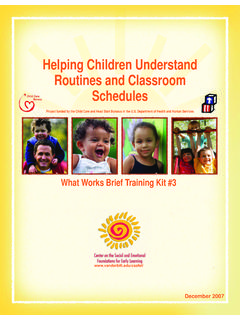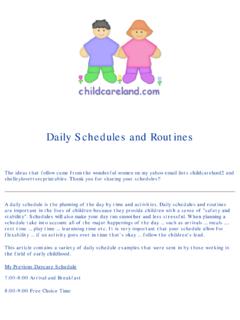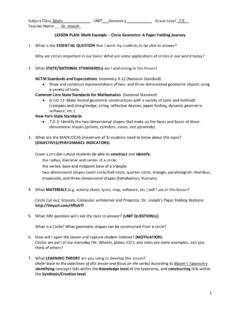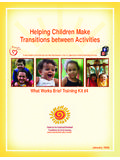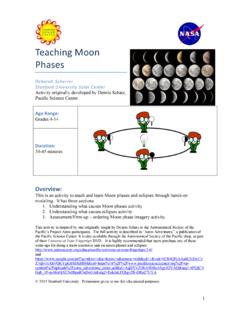Transcription of Games and Team Building Activities Getting to Know you ...
1 Games and Team Building Activities Getting to Know you Better/ Exploring Interests Affirmation circle : All those in the group form a circle . A leader will throw out get-to-know-you questions, and everyone that the question applies to goes into the middle of the circle for a high five while all those standing out of the circle clap. For example: everyone who speaks another language; anyone who is under age 10; anyone who is the oldest in their family, etc. Balloons with questions: Put a variety of different get-to-know-you questions into balloons that you blow up. Have the kids pick a balloon and sit in a circle . Let the kids pop the balloons at the same time and proceed around in a circle one person at a time letting the kids read the question and answer it.
2 A variation on this could be that everyone has the same questions and the kids put their responses on a sheet of paper without their names. They fold up the answers into a balloon and blow it up and tie it. Mix the balloons up and everyone pick a different one from their own. Have everyone sit in a circle and pop the balloons at the same time. One at a time the responses are read and guesses are made to see who wrote what. I'm going to mail a letter: Everyone is in a circle sitting on chairs where there is one less chair than the number of people in the group. The extra person stands inside the circle describing the group of people to whom he/she will mail a letter. All those for whom the description applies must get up and attempt to get the few chairs available.
3 The person must move if the description applies and go at least two chairs away. For example, I'm going to mail a letter to everyone that has spoken in front of a group . All those in the group who have publicly spoken, and the person that chose that particular group, volley for the available seats. The person left standing is in the middle giving a new description of the people to whom he/she sent a letter. Life stories: Provide paper and drawing utensils and have members of the group work individually on a drawing or representation of their life. It could be a time-line with significant events or just a picture of their favorite memory. You could ask some basic questions to stimulate their drawing: How many people are in your family? If you were an animal, what kind of animal would you be?
4 What do you think aliens look like?, etc. M&M s: Let everyone in the group take a handful of candy (without eating it). Have someone volunteer to go first and have them share one thing about themselves for every piece of candy they took. Another variation is having a roll of toilet paper and telling the group to take enough pieces to last them for a three-day camping trip. For every piece they share something about themselves. Name game with ball: While standing in a circle , everyone goes around and shares their name. Someone throws a Koosh or tennis ball to another person and says their name. The person who receives the ball responds by saying the name of the person who threw them the ball and the name of the person to whom they will throw it. For example, while I, Anna, throw the ball to Ahmed, I say, Here Ahmed.
5 Ahmed replies, Thanks, Anna, here Mia, and so on. The ball goes around the circle until everyone has a turn. Some variations might include going as fast as you can without dropping the ball or throwing additional balls into the circle . Name game with first initial: Participants sit in a circle and think of an adjective that begins with the same letter as their first name. One person starts by sharing his/her name combination. The next person first states the previous combination(s) before stating his/her own combination, going around the circle until it is complete. For example, jolly Jerry, awesome Andrea, bouncy Boulevy, and so on. You can vary the adjective and replace it with favorite food or leisure activity, etc. Another variation is not to tell students the trick of choosing a word the starts with the same letter as the student s first name, so the leader would start: I m Jamal, and I m going on a picnic and bringing jelly beans.
6 Each new participant lists the previous picnic-goers and adds their own name/food combination to see if they can come along on the picnic. They can keep trying until they catch on. Name-tags: Have paper and markers available for all the group members to make their own nametag/card/tent. They should include hobbies, favorite colors and foods, and tidbits of information about themselves. Have everyone present their nametag/card/tent and put them up every time you meet as a group. Team Building Create a Person: Each group gets a long piece of paper. The first person draws the head (not allowing others to see), then folds the drawing over so the next artist cannot see the head. The next person draws the neck, folds the paper, and passes it on. In each instance drawings are folded over so no one will know what the end result looks like.
7 The last person puts a name on it. When the folded paper is opened, roars of laughter follow. Groups can share drawings. Double Statue: This activity is good to try before brainstorming as a way to get creative juices flowing. It requires each team member to create something visual from an idea quickly and without any pressure or expectation to create a masterpiece work of art. An important lesson that can come out of this exercise is that what we do or say isn t always interpreted the way we intended. The group divides into pairs, in each pair one person is a lump of clay and the other person is the sculptor. The whole group plays at the same time, so there are several pairs scattered all over the room. The coach says sculpt, and the sculptors have one minute to create a sculpture out of their partner.
8 The clay s responsibility is to remain very pliable and just allow themselves to be sculpted. There should be no conversation during sculpting. After a minute the coach yells freeze. At this point the sculptures give a good hard freeze - no eye movement or motion whatsoever. In the beginning, stop the game here and go around and have the sculptors name their sculptures. The quicker this game is done the more creativity it calls for. For the double version of the game, when freeze is called, the sculptors switch to a different statue and become sculptures that fit with the other sculpture, guessing at what the other is supposed to be. For example: I have just sculpted an anteater and freeze is called. The coach says switch and I go to another statue that looks to me like an airplane.
9 I become a double sculpture by becoming a parachuter five feet away from the airplane. Meanwhile, another sculptor sees my anteater, thinks it is a person bowling, and becomes a bowling ball. In the end the coach goes around and asks each person who switched to name the double new sculpture, and asks the original sculptors what their sculptures were supposed to be. The second time the sculptors and lumps of clay switch so that everyone gets a chance to play both roles. Human Knot: Everyone in the group stands in a circle facing each other. Have people take their right hand and grab the right hand of another in the circle . Continue by joining people s left hands while making sure each team member grabs right and left hands of two different people. There should be a tangled web of arms amongst this circle , and the goal is to unwind this knot, without letting go of hands, until everyone is once again standing in a circle still holding hands.
10 Human Tic-Tac-Toe: Line up chairs in a 3 x 3 tic-tac-toe board formation. Two teams alternate in placing one team member at a time into a chair. The team with 3 members in a row wins. Line Up: Ask the large group of students to order themselves from oldest to youngest or from tallest to shortest. An interesting variation on this is to ask them to do it without any talking. Pair Up: People begin by pairing up, leaving one extra person who is the leader. They call out two body parts that the two people should have connected. Every time there is a new call, group members must switch partners. For example, if the leader calls out, ear to elbow , the ear of one person should find an elbow of a new partner. Paper Bag Skits: Compile 4 or 5 random articles per paper bag and divide into groups of 4 or 5.


